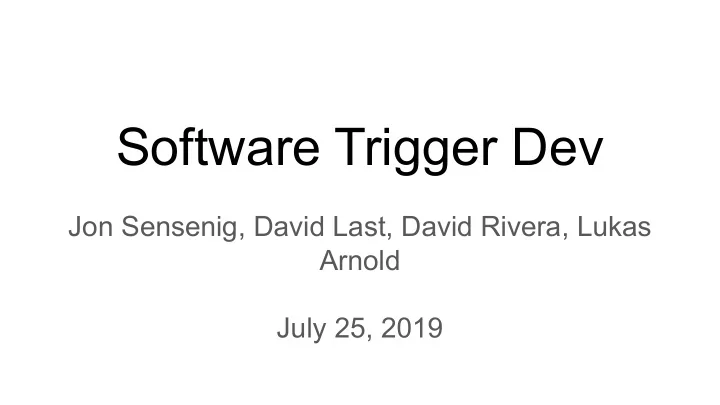

Software Trigger Dev Jon Sensenig, David Last, David Rivera, Lukas Arnold July 25, 2019
Data Flow Schematic of the current data flow ● development in ProtoDUNE. ● Hit-sending BR no longer necessary for Felix BR hit-finding APAs (due to artDAQ changes). Keep them under consideration but running w/o them now. 2
Candidate BR Window TPSets into Serialize TPSets 1. Aggregate and channel 50us windows (for from all links into sort TPs each link) single time-ordered 2. Find adjacency, using stream adjacency algorithm and generate TCs Data flow in the Candidate BR ● Candidate BR is for a single APA, (naming convention APA5: trigcand500, ● APA6: trigcand600) 3
MLT BR Time order TCs Aggregate TCs Generate artDAQ streams from Stitch TCs and fragment different APAs generate Trigger Decision with module algorithm Flow of data in the MLT BR ● MLT pushes it’s artDAQ fragment, initiating the readout from the other BRs ● “To Felix BR” tells the Felix BR to compress the data in anticipation of a data request. ● 4
Latency Candidate BR MLT BR Data Path: Hit-Finding (Felix BR) → Windowing → Serializing → TC Gen. → Received in MLT BR Figs. Lukas Arnold 5
Algorithm Overview (Horizontal Muon Trigger) Candidate Algorithm ● Adjacency Finding (1) Receive set of windowed (Δt = 50us) in time ○ and channel sorted TPs (2) Check for adjacency across channels within ○ time window for an APA (3) Returns largest adjacency, includes adjacency ○ endpoint coordinates (channel, time) (4) Generate TC if returned adjacency is greater ○ than or equal to 50 (configurable) 6 Fig. David Rivera
Algorithm Overview (Horizontal Muon Trigger) Module Level Algorithm ● (1) Stitch TCs together ○ Across time windows, allow for gap of 1 channel, 2 time ticks ■ Across APAs allow for gap of 1 channel, 10 time ticks ■ Constraint on slope difference of “track” stitching ■ (2) Generate trigger decision if “stitched track” has at least 450 wires hit in both APAs ○ (configurable) 7
Summary Latencies checked and are reasonable. Check again with complete trigger ● algorithm in place (addition of TC stitching at the module level) Full algorithm now in place in the BRs courtesy of ptmp & ptmp-tcs interface ● On monday detector’s LAr purity was lost so work offline until purity restored ● Check the data offline to verify trigger candidates make sense ● Check if trigger decisions are produced at MLT and verify offline ● To test online, ● Test full horizontal muon trigger algorithm. ○ Then compare this data to random trigger data, expect to see more horizontal muons from ○ the software trigger. 8
Backup Slides
● Full latencies in milliseconds ● Local trigger also known as Candidate Board reader ● Windowing and sorting happen with ptmp TPWindow and TPZipper respectively Fig. Lukas Arnold
Recommend
More recommend